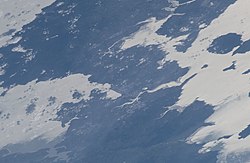Auckland isthmus | |
|---|---|
 The Auckland isthmus seen from the International Space Station in 2019 | |
Location in the Auckland Region | |
| Coordinates: 36°53′50″S 174°46′50″E / 36.89722°S 174.78056°E | |
| Location | Auckland Region, New Zealand |
| Age | Early Miocene, Quaternary |

The Auckland isthmus, also known as the Tāmaki isthmus,[1] is a narrow stretch of land on the North Island of New Zealand in the Auckland Region, and the location of the central suburbs of the city of Auckland, including the CBD. The isthmus is located between two rias (drowned river valleys): the Waitematā Harbour to the north, which opens to the Hauraki Gulf / Tīkapa Moana and Pacific Ocean, and the Manukau Harbour to the south, which opens to the Tasman Sea. The isthmus is the most southern section of the Northland Peninsula.
The Auckland isthmus is bound on the eastern side by the Tāmaki River and by the Whau River on the west; two tidal estuaries of the Waitematā Harbour.[2] These were used as portages by early Māori migration canoes and Tāmaki Māori to cross the isthmus (the Tāmaki River crossing known as Te Tō Waka, and the Whau River as Te Tōangawaka). Through early European settler history, canals were variously considered at either portage, however by the 1910s these projects were abandoned.
The isthmus was the centre of the Waiohua confederation of iwi in the 17th and early 18th centuries, who centred life around elaborate fortified pā of Maungawhau / Mount Eden and Maungakiekie / One Tree Hill. After the defeat of paramount chief Kiwi Tāmaki circa 1740, the isthmus became the rohe of Ngāti Whātua Ōrākei. In 1840, European settlers established the town of Auckland on the Waitematā Harbour, followed shortly after by the fencible towns of Onehunga, Ōtāhuhu and Panmure. The city developed outwards from the Port of Auckland, and by the mid-20th century the isthmus was almost completely urbanised. Originally organised as a variety of fractured land boards, boroughs and cities, the entire isthmus was amalgamated into a single local authority called Auckland City during the 1989 New Zealand local government reforms, which lasted until the 2010 unification of all local government in the Auckland Region to create the Auckland Council.
Since European colonisation of the region, the isthmus has seen major changes in landscape and infrastructure, including quarrying of scoria cones in the Auckland volcanic field, the draining of swamps and wetlands for farmland and housing and land reclamation on the Auckland waterfront. Large-scale infrastructure projects, including the rail network in the 1870s, the Auckland Motorways from the 1950s, and bridges (most notably the Auckland Harbour Bridge, opening in 1959 and connecting the isthmus to the North Shore), have fuelled population growth and suburban sprawl, both on the isthmus and in the greater Auckland Region.
- ^ Cite error: The named reference
AileenFoxwas invoked but never defined (see the help page). - ^ Brown, HJR (1960). "The Tamaki Isthmus". New Zealand Archaeological Association Newsletter. 3 (2): 21–22. Retrieved 8 November 2021.
